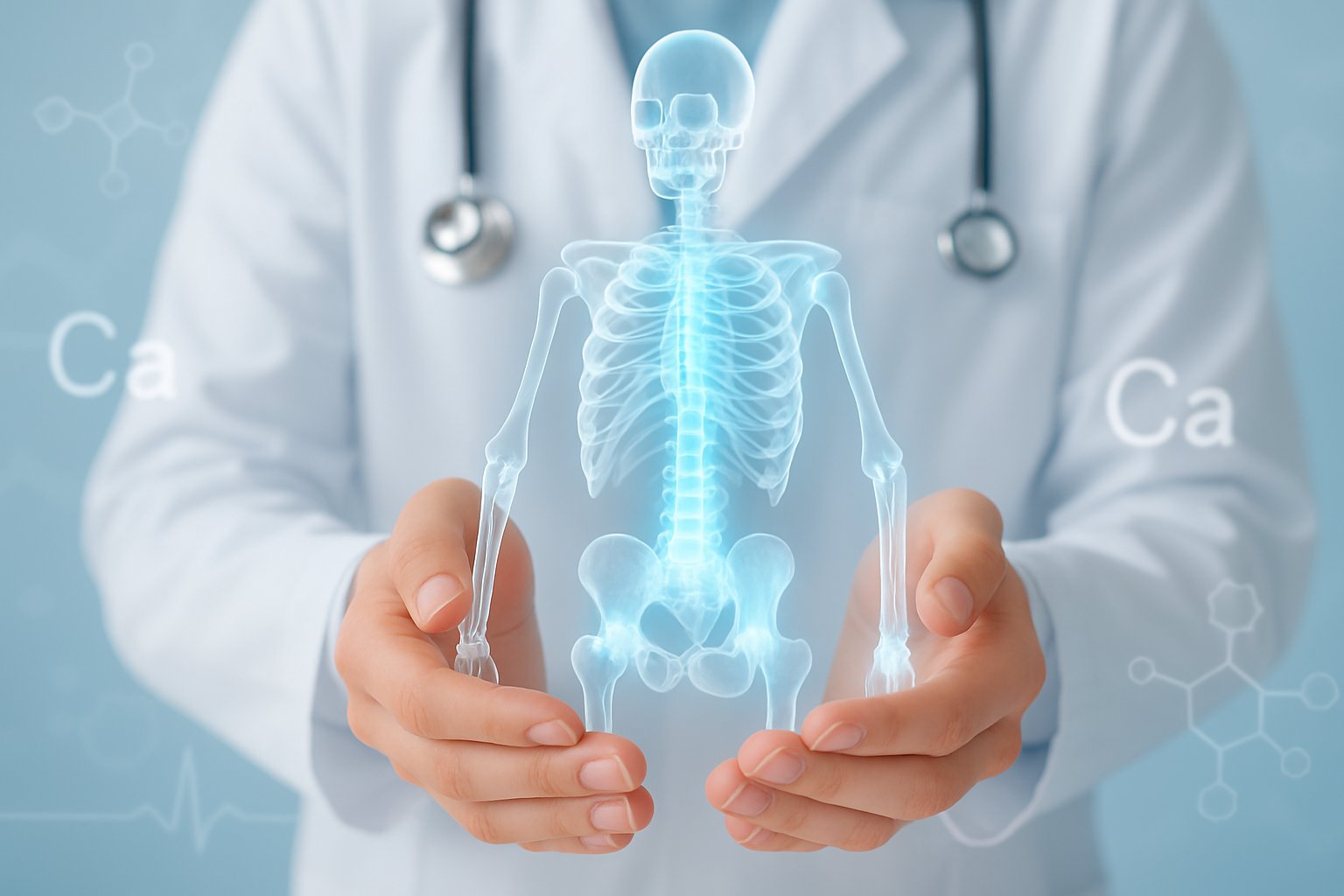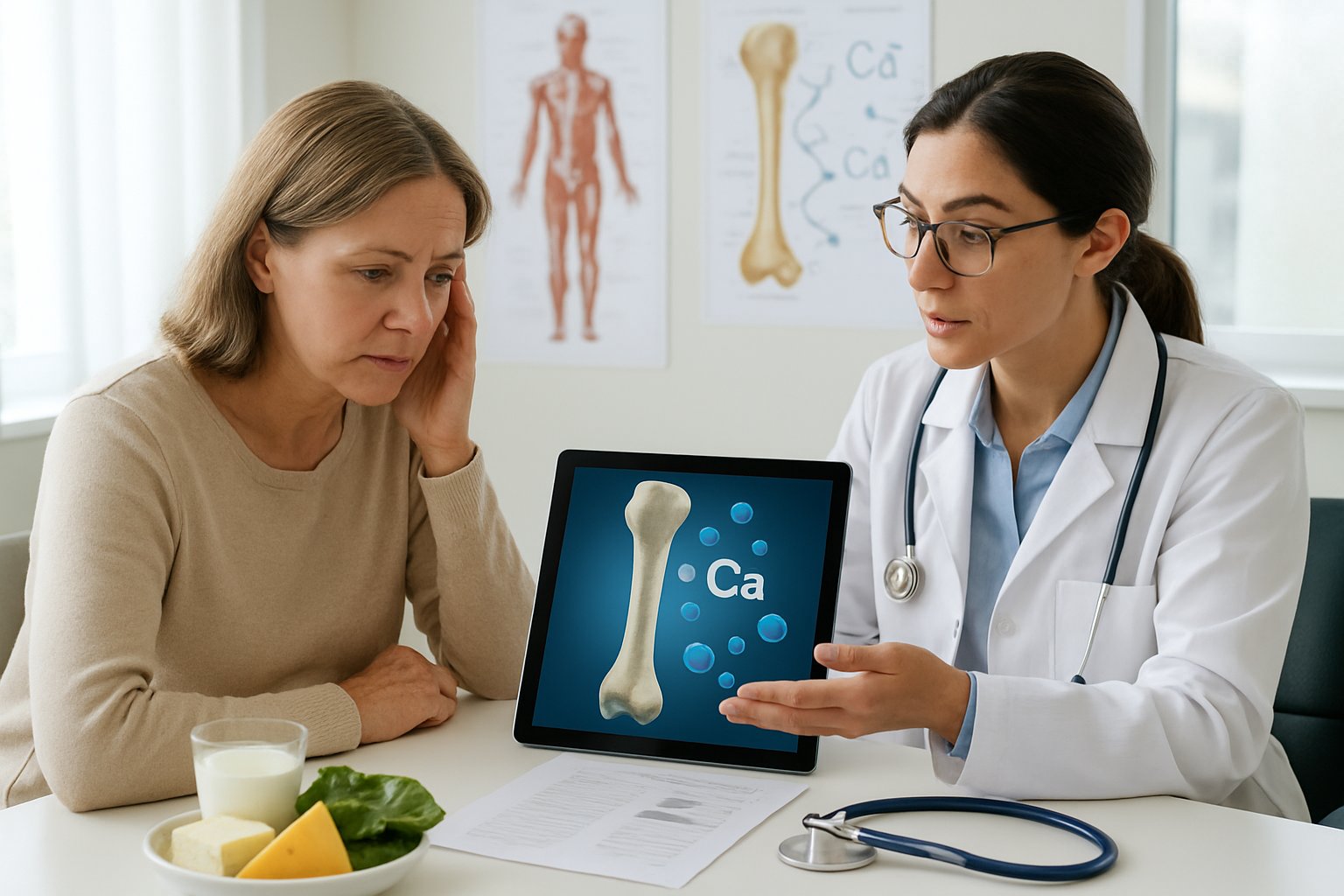When calcium levels drop too low in the blood, the body struggles to perform basic functions that keep you healthy. Low calcium can cause muscle cramps, tingling sensations, heart rhythm problems, and over time can lead to serious complications like confusion, depression, and memory issues.
Hypocalcemia affects people of all ages[1] and happens when the body cannot maintain proper calcium balance. The condition ranges from mild cases with few symptoms to severe situations that require immediate medical attention.
Understanding what triggers low calcium and recognizing the warning signs helps people take action before minor symptoms become major health problems. The good news is that most cases respond well to treatment when caught early.
Key Takeaways
- Low calcium causes muscle cramps, tingling, and can progress to serious heart and brain problems if left untreated
- The condition affects all age groups and often results from hormone imbalances, vitamin D deficiency, or underlying medical conditions
- Early detection and proper treatment can effectively manage low calcium levels and prevent long-term complications
Understanding Calcium and Its Role in the Body

Calcium serves as the body’s most abundant mineral and acts as an electrolyte that carries electrical charges through body fluids. The body maintains strict control over blood calcium levels at approximately 10 mg/dL to ensure proper functioning of vital processes.
Functions of Calcium
Calcium is essential for multiple body functions[2] beyond just building strong bones and teeth. The mineral plays a critical role in muscle contraction, allowing both skeletal muscles and the heart to function properly.
Blood clotting depends heavily on adequate calcium levels. Without sufficient calcium, blood has difficulty forming clots when injuries occur.
Nerve transmission requires calcium[3] to send signals throughout the nervous system. The mineral helps regulate nerve impulse conduction between cells.
Key calcium functions include:
- Bone and teeth formation
- Muscle contraction and heart rhythm
- Blood clotting processes
- Nerve signal transmission
- Hormone secretion
Types of Calcium in the Blood
Blood contains calcium in two main forms that doctors can measure. Total calcium level represents all calcium present in the blood, including both active and inactive forms.
Ionized calcium makes up the active portion that the body can actually use. This form carries an electrical charge and performs most of calcium’s important functions.
The inactive form binds to proteins, particularly albumin. When albumin levels change due to illness or other conditions, it affects how much calcium appears available in standard blood tests.
Calcium forms in blood:
- Ionized calcium: Active form (45-50%)
- Protein-bound: Attached to albumin (40-45%)
- Complexed: Bound to other substances (5-10%)
Normal Calcium Ranges
Normal blood calcium levels[3] typically range from 8.5 to 10.5 mg/dL for total calcium. Ionized calcium normally measures between 4.6 to 5.3 mg/dL.
These ranges may vary slightly between different laboratories. Age and health conditions can also influence what doctors consider normal for individual patients.
The body maintains calcium homeostasis[4] through complex interactions between bones, kidneys, and hormones. About 99% of the body’s calcium stays stored in bones, while only 1% circulates in blood and soft tissues.
Normal calcium ranges:
- Total calcium: 8.5-10.5 mg/dL
- Ionized calcium: 4.6-5.3 mg/dL
- Bone storage: 99% of body’s calcium
- Blood and tissues: 1% of body’s calcium
What Is Hypocalcemia?

Hypocalcemia occurs when calcium levels in the blood drop below normal ranges. Doctors typically diagnose this condition through routine blood tests and it can affect various groups of people differently.
Definition of Hypocalcemia
Hypocalcemia is a treatable condition that happens when the calcium levels in your blood are too low[1]. The body stores most calcium in bones, but some must circulate in the blood for proper function.
Normal blood calcium levels range from 8.5 to 10.5 milligrams per deciliter. When levels fall below this range, calcium deficiency develops.
Calcium serves as an electrolyte that carries electrical charges through body fluids. It helps muscles contract, nerves send signals, and blood clot properly.
Low calcium levels can result from:
- Poor calcium absorption
- Excessive calcium loss through urine
- Inadequate dietary calcium intake
- Problems with parathyroid hormone (PTH) production
The parathyroid glands produce PTH, which regulates calcium blood levels. When PTH levels drop or don’t work properly, hypocalcemia often develops.
How Hypocalcemia Is Diagnosed
Hypocalcemia is usually diagnosed with routine blood tests that measure the calcium level in the blood[5]. Doctors order these tests when patients show symptoms or during regular checkups.
Additional blood tests may check:
- Kidney function markers
- Magnesium levels
- Phosphate concentrations
- Parathyroid hormone levels
- Vitamin D status
Doctors might order follow-up tests if initial calcium levels appear low. They need to rule out lab errors and confirm the diagnosis.
Some medications can interfere with test results. Patients should tell their doctors about all medications and supplements they take.
The timing of blood draws matters. Calcium levels can vary throughout the day, so doctors may request multiple tests.
Commonly Affected Populations
Certain groups face higher risks for developing low calcium levels. Hospitalized patients experience hypocalcemia more frequently than the general population.
People at increased risk include:
- Older adults with poor nutrition
- Individuals with kidney disease
- Patients taking certain medications
- Those with vitamin D deficiency
- People who have had thyroid surgery
Kidney disease patients often develop calcium deficiency because their kidneys cannot properly regulate calcium. This can lead to bone problems like osteopenia or osteoporosis over time.
Adults who have undergone thyroid surgery may accidentally have parathyroid glands damaged. This can cause long-term issues with PTH production and calcium regulation.
People with limited sun exposure or poor diets may not get enough vitamin D. Without adequate vitamin D, the body cannot absorb calcium properly from food.
Causes of Low Calcium Levels

Low calcium levels develop when the body cannot get enough calcium from food or has trouble absorbing it properly. The most common reasons include not eating enough calcium-rich foods and problems with vitamin D that prevent proper calcium absorption.
Inadequate Dietary Calcium Intake
Many people do not consume enough calcium through their daily diet. Adults need 1,000 to 1,200 milligrams of calcium per day to maintain healthy blood levels.
Common calcium-rich foods include:
- Dairy products like milk, cheese, and yogurt
- Leafy green vegetables such as broccoli and kale
- Fish with soft bones like salmon and sardines
- Plant-based options including tofu and figs
People who avoid dairy products due to lactose intolerance often struggle to meet their calcium needs. They must find alternative sources or take supplements to prevent deficiency.
Certain eating patterns also increase the risk. Vegan diets require careful planning to include enough calcium from non-dairy sources.
Vitamin D Deficiency and Absorption Issues
Vitamin D deficiency[5] prevents the body from absorbing calcium properly, even when calcium intake is adequate. The intestines need vitamin D to move calcium from food into the bloodstream.
Low magnesium levels also interfere with calcium absorption. Magnesium helps activate vitamin D and supports parathyroid hormone function.
Several factors reduce calcium absorption:
- Certain medications like diuretics
- Kidney disorders that affect vitamin D activation
- Digestive problems that damage the intestinal lining
Low albumin levels in the blood can make calcium levels appear low on blood tests. However, this usually does not cause true calcium deficiency symptoms.
Underlying Medical Conditions and Other Risk Factors

Several medical conditions can disrupt calcium balance in the body, leading to dangerously low levels. Hypoparathyroidism affects hormone production[1], while kidney problems prevent proper calcium absorption and vitamin D conversion.
Parathyroid Disorders
The parathyroid glands control calcium levels through parathyroid hormone (PTH) production. When these small glands malfunction, calcium drops quickly.
Hypoparathyroidism occurs when the parathyroid glands produce too little PTH. This condition often develops after thyroid surgery when surgeons accidentally damage or remove parathyroid tissue.
Autoimmune disorders can also destroy parathyroid function[6]. The immune system attacks healthy parathyroid cells, reducing hormone output over time.
Some people inherit defective parathyroid glands that never work properly. These rare genetic conditions usually appear in childhood with severe calcium deficiency symptoms.
Risk factors for parathyroid problems include:
- Previous neck surgery
- Radiation therapy to the neck
- Family history of parathyroid disease
- Autoimmune conditions
Kidney Disease and Pancreatitis
Healthy kidneys convert vitamin D into its active form and help the body absorb calcium from food. Chronic kidney disease disrupts both processes.
Kidney failure reduces vitamin D activation[6], making it harder for the intestines to absorb dietary calcium. The kidneys also lose calcium through increased urination.
Patients with chronic kidney disease often develop phosphate buildup. High phosphate levels bind with calcium in the blood, creating compounds the body cannot use effectively.
Acute pancreatitis creates a different problem. The inflamed pancreas releases enzymes that bind with calcium, forming soap-like substances called calcium soaps.
This process removes usable calcium from the bloodstream rapidly. Severe pancreatitis cases can cause dangerous calcium drops within hours.
Medications and Chronic Illnesses
Certain medications interfere with calcium absorption or increase calcium loss through the kidneys. Anti-seizure drugs are common culprits.
Medications that lower calcium include:
- Phenytoin and phenobarbital
- Rifampin
- Chemotherapy drugs
- Some antibiotics
Chronic illnesses affect calcium through different mechanisms. Heart failure medications called diuretics increase calcium loss through urine.
Liver disease prevents proper vitamin D processing. Without active vitamin D, the intestines cannot absorb enough calcium from food sources.
Malabsorption disorders like Crohn’s disease damage intestinal lining. This prevents calcium uptake even when vitamin D levels are normal.
Hormonal Changes and Menopause
Estrogen helps the body maintain calcium balance by protecting bone density and supporting calcium absorption. Menopause dramatically reduces estrogen production.
Post-menopausal women lose calcium from bones at accelerated rates. The body pulls calcium from bone tissue to maintain blood levels, but this system eventually fails.
Menopause increases calcium deficiency risk through:
- Reduced intestinal calcium absorption
- Increased calcium loss through kidneys
- Faster bone calcium depletion
- Decreased vitamin D effectiveness
Thyroid disorders also affect calcium balance. Hyperthyroidism speeds up bone breakdown, releasing calcium too quickly for the body to regulate properly.
Some women develop calcium deficiency during breastfeeding. Milk production requires large amounts of calcium, which the body takes from maternal stores when dietary intake is insufficient.
Symptoms and Signs of Calcium Deficiency

Low calcium levels can cause problems throughout the body, from muscle issues to changes in appearance. The symptoms range from mild discomfort to serious health complications that require immediate medical attention.
Neuromuscular Symptoms
Muscle cramps are common early signs[1] of calcium deficiency. These cramps often occur in the back and legs first.
Muscle spasms can develop as calcium levels drop further. These involuntary contractions feel different from regular cramps and may be more intense.
Tingling sensations typically start in the:
- Lips and tongue
- Fingers and hands
- Feet and toes
Tetany is a serious condition where muscles contract and stay tight. This happens when calcium levels become very low.
Extremely low calcium can cause seizures[5]. These are medical emergencies that need immediate treatment.
People may also experience stiff, achy muscles that feel weak. Muscle contractions in the throat can make breathing difficult.
Skin, Hair, and Nail Changes
Dry, scaly skin develops when calcium stays low for long periods[7]. The skin may feel rough and look flaky.
Brittle nails break easily and appear weak. They may chip or crack more often than normal nails.
Hair becomes coarse and loses its normal texture. It may feel rough to the touch and look dull.
These changes happen gradually over time. People often notice nail problems before skin and hair changes become obvious.
Physical appearance changes include:
- Weak, thin nails that bend easily
- Patchy or extremely dry skin areas
- Hair that tangles more easily
Bone and Dental Health Impacts
Brittle bones develop because the body takes calcium from bones when blood levels are low. This makes bones weak and more likely to break.
Osteoporosis can result from long-term calcium deficiency. This condition makes bones very fragile and increases fracture risk significantly.
Osteopenia is an earlier stage of bone loss. Bone density decreases but has not reached the osteoporosis level yet.
Tooth decay increases when calcium levels stay low[8]. Teeth need calcium to stay strong and healthy.
Bone and dental problems include:
- Increased fracture risk
- Slower bone healing
- Cavities and dental issues
- Joint pain and stiffness
Children with calcium deficiency may have delayed tooth development. Adults often notice more dental problems during routine checkups.
Serious Health Consequences of Low Calcium

When calcium levels drop too low, the body experiences serious complications that affect both heart function and brain health. Severe calcium deficiency can affect your heart’s ability to pump blood effectively[7], while also causing significant mental health changes.
Cardiovascular Effects
Low calcium directly impacts how the heart beats and maintains blood pressure. The heart muscle needs calcium to contract properly and pump blood throughout the body.
Heart Rhythm Problems People with hypocalcemia often develop arrhythmias or abnormal heartbeat patterns. These heart arrhythmias happen because calcium helps control the electrical signals that make the heart beat steadily.
Without enough calcium, the heart may beat too fast, too slow, or irregularly. Some people experience dangerous rhythm changes that require immediate medical care.
Blood Pressure Changes Calcium helps blood vessels tighten and relax normally. When calcium is low, blood vessels cannot work properly.
This can lead to low blood pressure in some patients. The combination of heart rhythm problems and blood pressure changes makes hypocalcemia a serious heart condition.
Mental Health and Cognitive Symptoms
Hypocalcemia can cause confusion, depression, memory problems, delirium, and hallucinations[5] when it lasts for long periods. The brain needs calcium to send messages between nerve cells.
Mood and Emotional Changes Low calcium often causes depression and anxiety in patients. People may feel sad, worried, or hopeless without knowing why.
Irritability becomes common as calcium levels drop. Small problems may seem overwhelming or cause angry outbursts.
Cognitive Problems Memory loss affects many people with chronic hypocalcemia. They may forget recent events or have trouble learning new information.
Mental fatigue makes it hard to think clearly or focus on tasks. Some patients describe feeling like their thoughts are slow or fuzzy.
Severe cases can cause hallucinations or delirium, especially in older adults.
Diagnosis and Monitoring

Doctors use blood tests to detect hypocalcemia[9] before symptoms become obvious. They measure both total calcium and ionized calcium levels, along with related substances like albumin and parathyroid hormone.
Blood Tests for Calcium Levels
The total calcium level measures all calcium in the blood, including calcium bound to proteins. About 40% of blood calcium attaches to albumin and other proteins.
Ionized calcium measures only the active, unbound calcium that affects body functions. This test provides a more accurate picture of calcium status.
Doctors often measure albumin levels alongside calcium. When albumin is low, total calcium appears low even if ionized calcium is normal. The formula adjusts total calcium based on albumin levels.
Normal total calcium ranges from 8.5 to 10.5 mg/dL. Normal ionized calcium ranges from 4.6 to 5.3 mg/dL.
Blood calcium levels can be moderately low without causing symptoms initially.
Related Laboratory Assessments
Doctors test parathyroid hormone (PTH) levels to identify the underlying cause. PTH controls calcium balance in the body.
Magnesium levels help determine if low magnesium is reducing PTH activity. Low magnesium can cause calcium deficiency.
Vitamin D levels show if vitamin D deficiency contributes to low calcium. The body needs vitamin D to absorb calcium from food.
Phosphate levels help doctors understand mineral balance. Phosphate and calcium work together in the body.
Kidney function tests check if kidney problems cause calcium loss through urine. Poor kidney function affects calcium regulation.
These tests help doctors identify the specific cause of hypocalcemia[1] and choose the right treatment approach.
Managing and Treating Low Calcium

Treatment for low calcium depends on how severe the symptoms are and how quickly they developed. Acute symptomatic hypocalcemia requires intravenous calcium gluconate, while chronic cases are managed with oral calcium and vitamin D supplements[10].
Dietary Recommendations
Eating calcium-rich foods forms the foundation of managing mild calcium deficiency. Dairy products like milk, cheese, and yogurt provide easily absorbed calcium.
Top Calcium-Rich Foods:
- Dairy products: Milk (300mg per cup), cheese, yogurt
- Leafy greens: Kale, collard greens, bok choy
- Fish with bones: Canned salmon (180mg per 3oz), sardines
- Plant sources: Tofu (250mg per half cup), broccoli, figs
- Fortified foods: Orange juice, cereals, plant-based milks
Tofu made with calcium sulfate contains significant amounts of calcium. Canned salmon with bones provides both calcium and vitamin D. Broccoli offers moderate calcium levels plus other nutrients that support bone health.
Figs contain decent calcium amounts for a fruit. People should eat these foods regularly rather than relying on occasional large portions.
Calcium and Vitamin D Supplements
Oral supplements treat chronic low calcium effectively when dietary changes alone are insufficient. The body needs vitamin D to absorb calcium properly.
Common Calcium Supplements:
| Type | Absorption | Best Taken |
|---|---|---|
| Calcium carbonate | Needs stomach acid | With meals |
| Calcium citrate | Absorbed easily | Anytime |
| Calcium gluconate | Gentle on stomach | With or without food |
Calcium carbonate contains the most elemental calcium per pill but requires stomach acid for absorption. Calcium citrate absorbs better in people with low stomach acid or those taking acid-blocking medications.
Most adults need 1,000-1,200mg of calcium daily. Taking more than 500mg at once reduces absorption. Magnesium supplements help calcium work better in the body.
Medications and Advanced Therapies
Severe or symptomatic low calcium requires immediate medical treatment. Intravenous calcium gluconate is the preferred therapy for acute symptomatic hypocalcemia[10].
Calcium injections deliver calcium directly into the bloodstream during emergencies. Doctors typically use calcium gluconate because it causes less tissue damage if it leaks from the vein.
Advanced Treatment Options:
- IV calcium gluconate: For severe symptoms or emergencies
- Prescription vitamin D: Calcitriol or other active forms
- Thiazide diuretics: Help kidneys retain calcium
- Parathyroid hormone therapy: For specific hormone deficiencies
Prescription-strength vitamin D medications work faster than over-the-counter versions. Doctors may prescribe calcitriol, which the body can use immediately without conversion.
Some patients need ongoing monitoring and adjustment of medications. Treatment continues until calcium levels stabilize and symptoms resolve.
Prevention and Long-Term Management
Preventing low calcium levels[1] requires consistent dietary habits and regular monitoring. People at higher risk need ongoing medical supervision to maintain healthy calcium levels.
Lifestyle and Dietary Habits
Daily calcium intake forms the foundation of prevention. Adults need 1,000-1,200 mg of calcium daily from food sources or supplements.
Dairy products provide the most calcium per serving. One cup of milk contains about 300 mg of calcium. Yogurt and cheese offer similar amounts.
Non-dairy calcium sources include:
- Leafy green vegetables like kale and collard greens
- Canned fish with soft bones
- Fortified plant-based milk alternatives
- Almonds and sesame seeds
Vitamin D helps the body absorb calcium effectively. People need 600-800 IU daily through sunlight exposure, food, or supplements.
Bone health depends on regular weight-bearing exercise. Walking, dancing, and strength training help maintain bone density and prevent osteopenia.
Limiting caffeine and alcohol supports calcium absorption. These substances can increase calcium loss through urine when consumed in large amounts.
Monitoring at Risk Populations
Certain groups need regular blood tests to check calcium levels. Older adults face higher risks of developing osteoporosis due to decreased calcium absorption.
High-risk individuals include:
- People with kidney disease
- Those taking seizure medications
- Patients with digestive disorders
- Individuals with parathyroid problems
Healthcare providers typically check calcium levels every 6-12 months in at-risk patients. More frequent testing may be needed for people with active medical conditions.
Bone density scans help detect early signs of bone loss. Women over 65 and men over 70 should have regular screenings for osteoporosis.
People with chronic conditions affecting calcium absorption need specialized care plans. Their doctors may adjust medications or recommend higher supplement doses to maintain proper levels.
Frequently Asked Questions
Low calcium levels can cause symptoms ranging from muscle cramps to serious heart problems. Understanding the signs, complications, and treatment options helps people manage this condition effectively.
What are the common symptoms of low calcium levels?
Moderately low calcium levels may not cause any symptoms[5] at first. When symptoms do appear, they often include muscle cramps in the back and legs.
Long-term low calcium can cause dry, scaly skin and brittle nails. Hair may become coarse and break easily.
Mental symptoms can develop over time. These include confusion, depression, and memory problems.
Extremely low calcium levels cause more serious symptoms[5]. People may feel tingling in their lips, tongue, fingers, and feet.
Severe cases can lead to muscle spasms, seizures, and abnormal heart rhythms. Muscle spasms in the throat can make breathing difficult.
Can hypocalcemia lead to serious health complications?
Yes, untreated low calcium can cause dangerous complications. Heart rhythm problems can range from mild to life-threatening[11].
Seizures can occur when calcium levels drop very low. These seizures can be dangerous without proper treatment.
Muscle spasms in the throat and chest can affect breathing. This creates a medical emergency that needs immediate care.
Long-term low calcium weakens bones over time. This increases the risk of fractures and breaks.
Mental health problems like depression and confusion can affect daily life. Memory issues may worsen without treatment.
What dietary changes can help increase calcium levels?
Dairy products provide the most calcium per serving. Milk, cheese, and yogurt are excellent choices for most people.
Green leafy vegetables offer calcium for those who cannot eat dairy. Kale, collard greens, and broccoli contain good amounts.
Canned fish with soft bones provides calcium and protein. Sardines and canned salmon are particularly rich sources.
Fortified foods add extra calcium to the diet. Many plant-based milks, cereals, and orange juices contain added calcium.
Nuts and seeds contribute smaller amounts of calcium. Almonds, sesame seeds, and tahini are good options to include regularly.
How does vitamin D deficiency affect calcium absorption?
Vitamin D helps the body absorb calcium from food. Vitamin D deficiency can be caused by inadequate sun exposure or not consuming enough vitamin D in the diet[5].
Without enough vitamin D, the body can only absorb about 10-15% of dietary calcium. With adequate vitamin D, absorption increases to 30-40%.
The kidneys need vitamin D to activate calcium absorption. Kidney disorders can cause the kidneys to be less able to activate vitamin D[5].
Sun exposure helps the skin make vitamin D naturally. About 10-30 minutes of midday sun several times per week is usually enough.
Foods like fatty fish, egg yolks, and fortified products provide vitamin D. Supplements may be needed for people with limited sun exposure.
What are the treatment options for chronic low calcium?
Treatment for hypocalcemia includes supplementation with calcium and vitamin D[5]. Most people can take oral supplements at home.
Severe cases may need calcium given through an IV. This happens in hospitals when levels are dangerously low.
If an underlying disorder is causing low calcium levels, that disorder will need to be treated[5]. Parathyroid problems often require specific hormone treatments.
Some medications can cause low calcium as a side effect. Changing medications may help restore calcium levels[5] when possible.
Regular blood tests help doctors monitor calcium levels during treatment. This ensures the treatment is working properly.
Is it possible to have low calcium and not show any symptoms?
Yes, many people with mildly low calcium have no symptoms at all. Moderately low blood calcium levels may not cause symptoms[5] for weeks or months.
Hypocalcemia is usually diagnosed with routine blood tests[5] rather than from symptoms. Many cases are found during regular checkups.
Symptoms usually develop gradually as calcium levels drop further. The body can adapt to mild deficiencies for some time.
Age and overall health affect when symptoms appear. Older adults and people with other health problems may notice symptoms sooner.
Early detection through blood tests allows treatment before symptoms develop. This prevents more serious complications from occurring.
References
- Hypocalcemia: Causes, Symptoms & Treatment. https://my.clevelandclinic.org/health/diseases/23143-hypocalcemia Accessed October 25, 2025
- Overview of Calcium's Role in the Body - Hormonal and Metabolic Disorders. https://www.msdmanuals.com/home/hormonal-and-metabolic-disorders/electrolyte-balance/overview-of-calciums-role-in-the-body?query=calcium Accessed October 25, 2025
- No Title – Open Educational Resources | Open Educational Resources. https://open.oregonstate.edu/anatomy2e/chapter/calcium-homeostasis/ Accessed October 25, 2025
- 6.5A: Bone and Calcium Homeostasis. https://med.libretexts.org/Bookshelves/Anatomy_and_Physiology/Anatomy_and_Physiology_(Boundless)/6%3A_Skeletal_System/6.5%3A_Bone_and_Calcium/6.5A%3A_Bone_and_Calcium_Homeostasis Accessed October 25, 2025
- 14 Hypocalcemia (Low Calcium) Symptoms, Signs, Causes, Treatment. https://www.emedicinehealth.com/what_does_hypocalcemia_cause/article_em.htm Accessed October 25, 2025
- Hypocalcemia - Endocrine and Metabolic Disorders. https://www.merckmanuals.com/professional/endocrine-and-metabolic-disorders/electrolyte-disorders/hypocalcemia Accessed October 25, 2025
- Dry, scaly skin develops when calcium stays low for long periods. https://www.health.com/calcium-deficiency-symptoms-7976013 Accessed October 25, 2025
- Tooth decay increases when calcium levels stay low. https://www.verywellhealth.com/calcium-deficiency-symptoms-11733946 Accessed October 25, 2025
- Hypocalcemia (Low Level of Calcium in the Blood) - Hormonal and Metabolic Disorders. https://www.merckmanuals.com/home/hormonal-and-metabolic-disorders/electrolyte-balance/hypocalcemia-low-level-of-calcium-in-the-blood Accessed October 25, 2025
- UpToDate. https://www.uptodate.com/contents/treatment-of-hypocalcemia Accessed October 25, 2025
- Heart rhythm problems can range from mild to life-threatening. https://www.verywellhealth.com/hypocalcemia-overview-4774539 Accessed October 25, 2025
